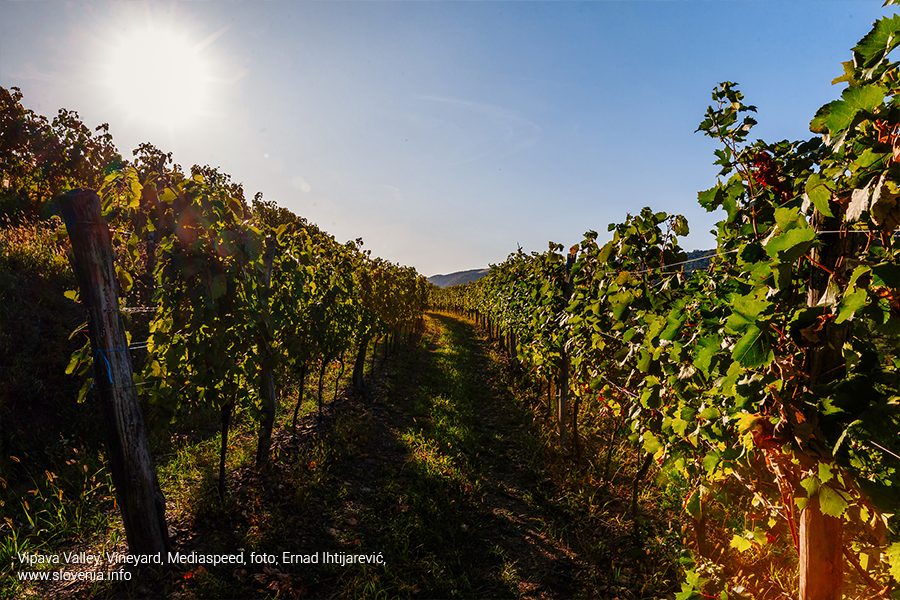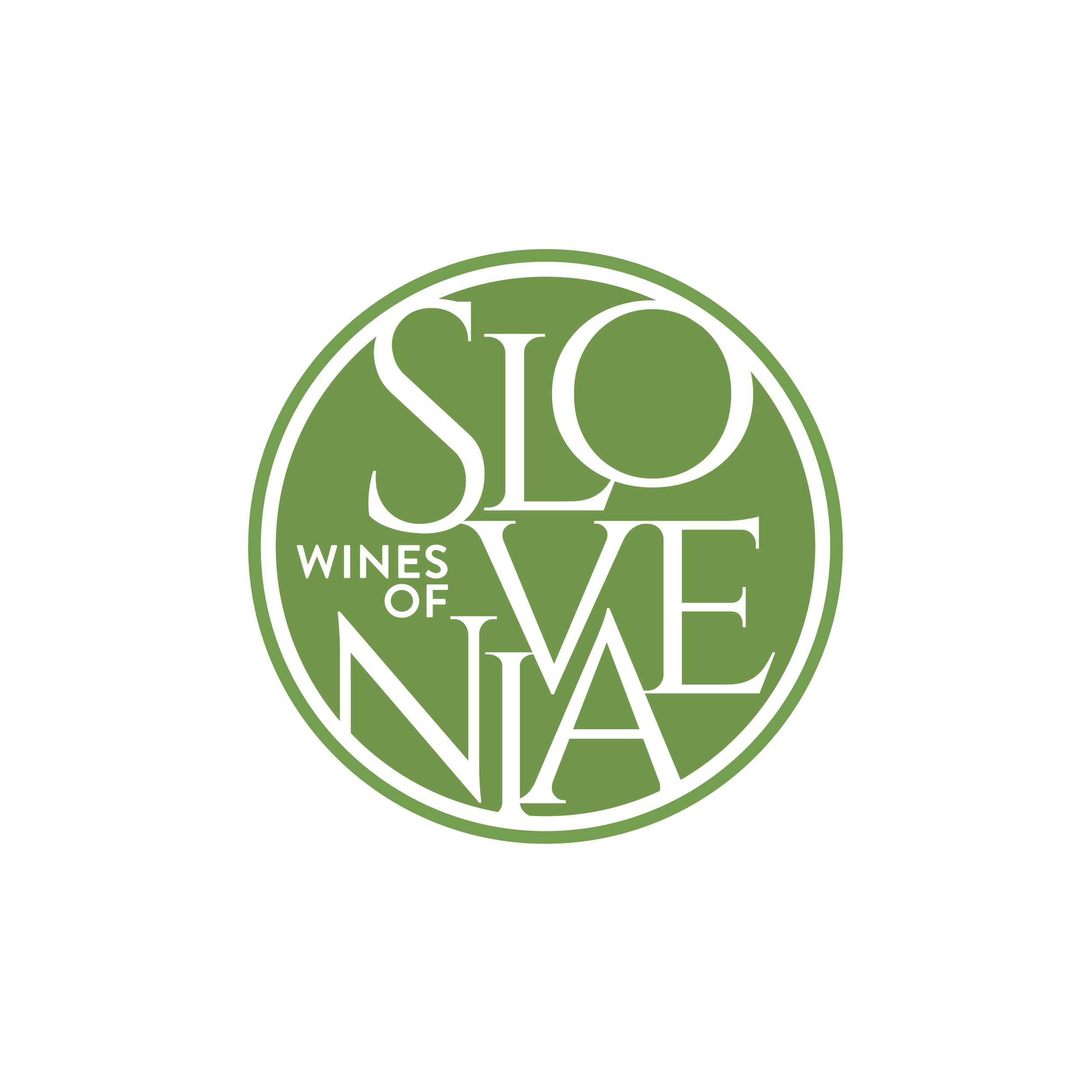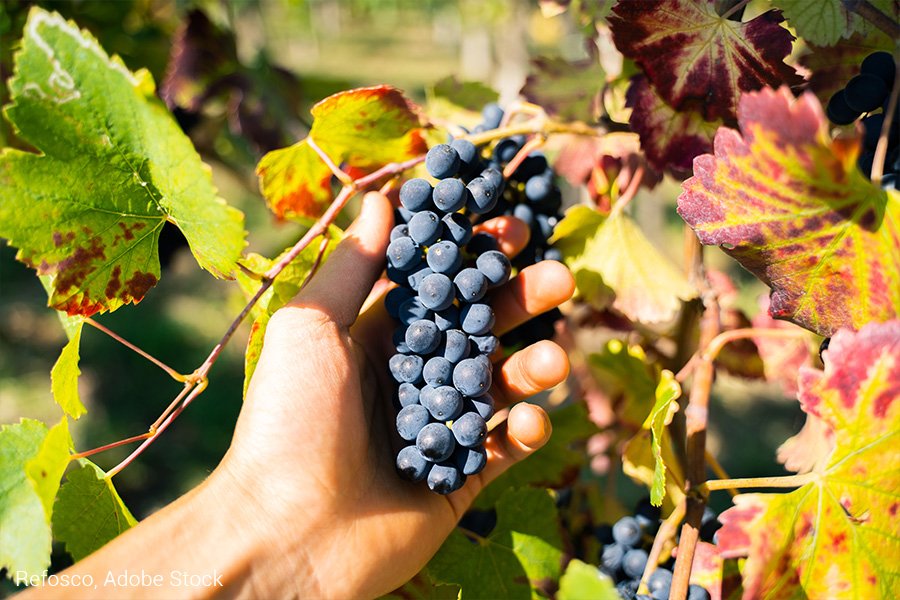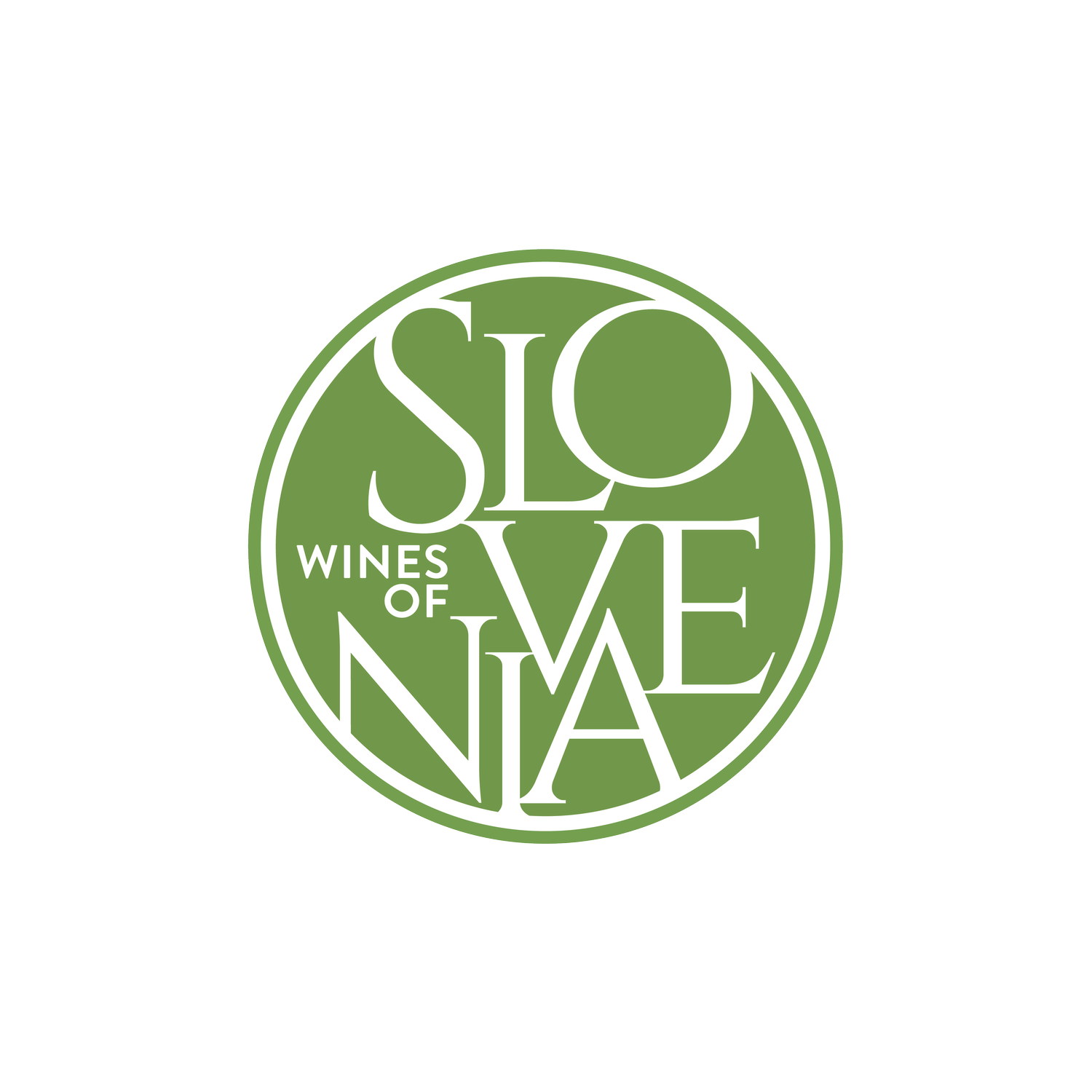
SLOVENIA’S GRAPE VARIETIES
SLOVENIAN GRAPE VARIETIES
A total of 60 grape varieties are authorized in Slovenia: 38 white and 22 red. Many of them are native to the region and have a long tradition of cultivation. International varieties were introduced to Slovenia in 1822 and have been successfully grown since. Some Central European varieties have been grown in Slovenia for so long, they have become traditional.
Native Grapes
The birthplace of some of these varieties lies outside the borders of modern-day Slovenia, but because of the complicated land history of Central Europe, winemakers consider them local.
WHITE
-

Laški Riesling (Welschriesling)
Welschriesling is widespread in Central Europe and with 1,658 hectares is the most planted grape in Slovenia, predominantly in the cooler climate of Podravje. Often light, neutral and easy to drink, Laški is also able to produce intense, high-quality wine when terroir is taken into account. And of course, this grape is famous for their stunning ice wine, that have won numerous important medals and trophies at international competitions.
Laški has high acidity, a rather light body and gentle aromas of white blossom, honey, ripe apples and citrus. Interestingly, it bears no relation to Riesling.
-

Chardonnay
Present in Slovenia since 1822, Chardonnay is grown in all nine wine districts. The total planted area is 1,185 hectares. Chardonnay is a neutral grape variety, and its style reflects the origin. In cooler areas (such as Štajerska Slovenia and Bela Krajina) it has higher acidity and a medium body. In warmer Brda and Prekmurje, the body is fuller and the aromas are tropical. Some very serious oak-aged Chardonnays are produced in Slovenia, as well as high-quality sparkling wines.
-

Sauvignon Blanc
Sauvignon Blanc, or simply “Sauvignon” in Slovenia, accounts for 1,139 hectares of vineyards. This aromatic, cool-climate variety is especially important in Štajerska Slovenia, Vipava Valley and in Goriška Brda. Most Sauvignons are produced in stainless steel, giving pungent, highly aromatic wines. In Brda and Štajerska Slovenia there is a long tradition of oak-aging for Sauvignon. The resulting wines have an elegant aroma profile, full body and creamy texture.
-

Malvazija Istarska / Malvasia Istriana
Malvazija, is a grape variety that traces its origins to Istria, the peninsula situated at the northern end of the Adriatic Sea. Notably, this Malvasia is distinct from other varieties carrying the same name, and recent genetic research has revealed that it has no Greek parentage, as previously believed.
Malvazija is highly regarded for its ease of cultivation, consistently delivering good yields. It is exceptionally popular as a crisp, zesty, and refreshing coastal wine, perfectly complementing local seafood dishes. However, the range of styles produced from Malvazija is quite diverse, encompassing full-bodied, powerful, spicy, and sometimes barrel-aged or macerated wines.
The finest Malvazija wines typically feature a bright floral bouquet with aromas of apricot, peach, and a distinctive honeyed note. Malvazija thrives in cooler sites, benefiting from the influence of sea breezes and cooler nights. These conditions contribute to elevating its typically low acidity and help maintain a moderate alcohol level in the wine.
With 966 hectares Malvazija is a significant grape variety in all four districts of the Primorska region. It stands as the most important white grape in Slovenska Istra, covering 30% of the total area, second only to the red Refošk.
-

Rumeni Muškat (Muscat Blanc à Petits Grains)
Muscat Blanc à Petits Grains is a very old variety with 591 hectares planted in Slovenia. These wines have an intense grapey, floral, tropical, spicy scent. Most Muscats are made as medium-sweet or sweet wine and enjoyed locally, although some are dry and aromatic. Traditionally, most Muskat is planted in Štajerska Slovenija, but it is increasingly popular in Istria. A tiny quantity (only 17 hectares) of world-class sweet Muskat comes from Bela Krajina.
-

Rebula
Rebula (aka Ribolla Gialla) is native to Goriška Brda and Italian Collio. Planted on the steep hills and terraces it brilliantly showcases terroir with its light chalk dust minerality.
High in acidity, restrained on the nose, with aromas of bright citrus, ripe yellow fruit, nuts, white blossom and gentle spices, Rebula is very versatile in winemakers’ hands. It produces fresh, barrel-aged, macerated, sparkling and sweet wine styles. It is a late ripening, thick-skinned variety. Thus, when macerated on skins it has an impressive, powerful, but fine tannic structure.
Rebula was almost abandoned three decades ago, but it has since experienced a remarkable resurgence and has become a fashionable and celebrated grape variety. Its revival is so prominent that it has even earned its own international conference, underscoring its growing importance in the world of wine.
595 hectares of vineyards are planted with Rebula, making Slovenia the largest producer of Rebula.
-

Renski Rizling (Riesling)
Riesling is an ancient German variety that accounts for 614 hectares in Slovenia. A cool climate grape, it grows well in Podravje. The styles produced in Slovenia range from dry and steely to lusciously sweet wines (and occasionally ice wine).
-

Sivi Pinot (Pinot Gris)
Pinot Gris is a pink-skinned grape that traditionally makes white wines. In Slovenia, slightly-pink, almost rosé wines from Pinot Gris have been very popular lately. Almost half of these wines are produced in Štajerska Slovenia for a fresh and aromatic style of Pinot Gris. Goriska Brda has many fuller bodied, characterful bottlings, produced in stainless steel or in old oak.
-

Šipon / Furmint
An ancient Hungarian grape, Furmint is a late-ripening grape with an elegant and fine aromatic profile: yellow apples, pear, pineapple, ginger, meyer lemon, white blossom and a touch of benzol.
Due to its high acidity and characterful aromas Furmint is a very versatile grape: world-class fresh and barrel-aged dry wines, sparkling as well as late-harvest or botrytis-affected sweet wines are produced.
Best Šipons come from the village of Jeruzalem and Haloze hills in Štajerska. These wines have a long aging potential.
The story of the local name goes back to the 19th century when the French were momentarily colonizing Slovenia. Tasting the local Furmint they were saying: "C'est si bon!" ("it's so good!"), and the name Šipon (Shee-pon) was born.
-

Beli Pinot (Pinot Blanc)
In Slovenia, there are 445 hectares of Pinot Blanc planted. It creates fruity wines with rather high acidity. More than half of the country’s Pinot Blanc is planted in Štajerska Slovenija, where most of it is used as a blending component. Some notable varietal Pinot Blancs are produced in Brda.
-

Sauvignonasse
Sauvignonasse, also known as Sauvignon Vert or Friulano, is often referred to as “Tokaj” by locals in some regions. The historic name was changed after Hungary obtained a Protected Designation of Origin (PDO) for its Tokaj wine region. Ironically, you may see the name ‘jakot’ on the label of many bottles.
It is a semi-aromatic variety with intense aromas of citrus, pear and tropical fruits, along with a distinctly vegetal, herbal character (mint, thyme, sage, oregano). It is medium to full-bodied wine with uplifting acidity. Many highly distinctive bottlings are produced ranging from fresh, youthful style to rich barrel-aged wines. Skin contact (not always long) accentuates the grape’s character and provides the wine with smooth gentle tannins.
Due to its aromatic profile, it is a popular blending partner.
There are 243 hectares of Sauvignonasse planted in Slovenia, mostly in Goriška Brda.
-

Traminec (Traminer) and Dišeči Traminec (Gewürztraminer)
Traminer is an ancient French or German variety with 210 hectares of plantings in Slovenia. Another 30 hectares of its more aromatic mutation – Gewürztraminer – is planted. The two are often interplanted and blended. Traminer arrived in Slovenia in 1822, and has been popular ever since. It is primarily planted in cool climate Štajerska Slovenia which produces wines in dry to medium-sweet style, with varietal aromas of roses, oriental spices and lychee.
-

Kraljevina
Kraljevina is planted on 170 hectares in the Posavje region, but almost always - as a rather neutral grape variety with high acidity and lower alcohol level - ends up in various local white blends as well as in Cviček. Kraljevina has also been used to craft notable botrytis wines in the past two decades.
-

Zelen
Zelen is an old, indigenous grape variety native to the Vipava Valley and it thrives in the distinctive 'opoka' soil of the area. Wines made from Zelen are known for their crisp and lightly aromatic character, featuring delicate grassy notes and aromas reminiscent of dried Mediterranean herbs, apricots, and lemon juice.
The name "Zelen" in Slovenian translates to 'green,' which is quite fitting given its herbal and refreshing aromatic qualities. In the past, it was also associated with the emerald-like color of the unfiltered grape must.
Zelen wines are best produced in a fresh style, often vinified in stainless steel or concrete vats to preserve their vibrant personality. The finest versions of Zelen have good aging potential. These wines are well-suited as aperitifs and pair wonderfully with light summer dishes and salads, making them a delightful choice for warm-weather dining.
With its 86 hectares of vineyards, Vipava Valley stands as the exclusive source of the Zelen grape variety.
-

Ranina / Bouvier
Ranina is an indigenous Slovenian variety. 80 hectares are planted in Štajerska Slovenija. Clotar Bouvier, an Austrian banker and landowner, discovered it in 1900 in his vineyards close to Gornja Radgona.
The name means ‘the early’ and reflects its early ripening habit. Ranina wines are lightly perfumed with notes of Muscat and tropical fruit and have low acidity.
-

Pinela
Pinela is an old variety, whose origin is not fully clear, but winemakers of Vipava Valley consider it a local specialty. Pinela produces delicate floral wines with the aromas of jasmine, peach, pineapple and grapefruit, full body, elevated acidity and a smooth, somewhat oily texture.
Pinela has been gaining popularity in recent years, and its cultivation has increased to 65 hectares of vineyard area. More and more wine producers are choosing to vinify it as a varietal wine, some from very old vines. Pinela is known for its gentle and delicate nature in the vineyard. Cultivating and nurturing it demands a masterful touch.
-

Rumeni Plavec
Rumeni Plavec is an indigenous variety of either Slovenia or the neighboring Croatia. Known for its very high acidity, it is mainly used as a blending grape that contributes freshness to the Bizeljsko-Sremič and Dolenjska districts. Recently, it has been gaining popularity as a premium blending component for sparkling wine.
-

Vitovska (Vitovska Grganja)
This rare grape variety, initially found in the Kras district, is extremely hardy. It resists cold winters, strong ‘Burja’ winds and arid hot summers. Native to the terra rossa terroir, Vitovska has high acidity, lively salinity and aromas of Meyer lemon, pear, quince, hay and iodine. Skin contact adds notes of tangerine and cinnamon, dried flowers and sage, as well as smooth tannins.
Although the Vitovska vineyard area remains rather small (34 hectares), it has almost doubled in the Karst and the Vipava Valley in the past years.
-

Ranfol
Ranfol is an ancient grape variety likely originating in Štajerska Slovenija. Before phylloxera, at the end of the 19th century, it used to be the most planted grape in Štajerska. It produces light wines with a rather neutral character. Currently, there are 22 hectares of Ranfol planted in Dolenjska and Štajerska Slovenija.
-

Pikolit (Picolit)
Pikolit is an ancient Friulian grape variety that thrives in marl soils and requires ample sunshine to ripen fully. The sun-drenched hills of Brda provide an ideal environment for this grape to flourish. However, Pikolit is not widely planted due to inherent challenges related to fruit set and unpredictable yields. It can produce high-quality wines, both dry and sweet, known for their full body, elevated acidity, and aromas of stone fruit, honey, tangerine, ginger, mango, and orange blossom.
-

Klarnica
This extremely rare (only 3 hectares!) indigenous variety from Vipava valley is beginning to attract attention. Klarnica wines are typically full-bodied with surprisingly sweet aromas of pear, baked apple, tangerine, grapefruit and tea roses. Some bottlings are produced with short skin contact that accentuates deep fruit aromas. A rare, sweet version made of dried grapes can be found.
RED
-

Refošk/ Refosco
Refošk is an ancient variety originating from the Karst plateau. With 1,295 hectares, it is the most widely planted red grape in Slovenia, with most of the plantings in Kras and Istra.
Refošk is famous for its deep purple-ruby color. The nose is expressive, with aromas of violet, red rose, forest fruit and black currant, pepper and juniper. The wine has very high acidity, pronounced tannins, and a medium to full body. Refošk wines range from ordinary wines to delicious and original oak-aged sturdy reds that can age well. It is often blended with Cabernet Sauvignon, Merlot and Syrah.
In Kras, Refošk grows on terra rossa soils, producing an opaque red called Teran which possesses a lighter body and even more acidity. Teran is a protected historical designation (PTP).
-

Žametovka / Žametna Črnina
Žametovka is an ancient Slovenian variety originating from the Dolenjska region. Žamet means 'velvet'.
Very little of solely Žametovka is bottled, but it is an important blending grape, providing acidity and bright fruit character. In Dolenjska it helps to make the traditional low-alcohol, pale-red, highly acidic Cviček. In Bizeljsko-Brežice the blend is called Bizeljčan, while in Bela Krajina it is Metliška črnina. The variety has great potential for sparkling wines.
Although it is hard to find Žametovka internationally, the variety is quite important. In Maribor, in the Podravje region, a huge 400-year-old Žametovka vine named Stara Trta grows on the river bank. Its status as the world’s oldest vine was recognized in the 2004 Guinness book of records. The vine yields 35–55 kg (77–121 lbs) of grapes per year, giving around a hundred 25 cl bottles of wine, a true collector’s item.
-

Merlot
Merlot - with its 822 - hectares is the number one international variety in Slovenia. Often easy-drinking and crowd-pleasing, Slovenian Merlot has a long history and is responsible for some of the most expensive and exclusive Slovenian red wines.
Slovenian Merlot has cherry, plum and blackberry aromas with notes of herbs (oregano and mint) and a long and velvety finish. It grows successfully in all the Primorska districts, producing varietal wines as well as blends.
-

Modra Frankinja / Blaufränkisch
Blaufränkisch is long believed to have a general Central European origin. But in 2016, a German scientist from the Julius Kühn Institute in Geilweilerhof proved the variety's birthplace to be Slovenia.
Blaufränkisch needs a rather warm climate and produces characterful deeply colored wines with notes of dark fruit, violet and iris, black pepper, and dried herb. It has uplifted juicy acidity with medium tannin levels. The variety is terroir-driven and capable of a wide range of styles: from light, fresh and fruity to deeply flavored and firmly structured age worthy wines.
In Slovenia, 610 hectares are planted with Modra Frankinja, mostly in Posavje and Podravje regions and it is increasingly gaining popularity.
-

Cabernet Sauvignon
This French grape is the most planted grape on Earth, and of course you can find it in Slovenia, as well. Only the 15th most planted grape, it struggles to ripen in parts of Slovenia, succeeding best in the warmer Primorska region. In Slovenia, Cabernet Sauvignon is produced as both varietal wine and part of a blend.
-

Modri Pinot (Pinot Noir)
Surprisingly, cool-climate loving Pinot Noir is grown in all nine Slovenian wine districts. Thus, the style varies significantly. In Štajerska Slovenia, it is a classic style with aromas of red fruit, roses and forest floor. In warmer Primorska, however, it is a more lush, ripe wine with a bigger body. Some of the best Slovenian reds are Pinot Noirs.
-

Barbera
Barbera is a deeply colored, high acidity specialty of the Vipava Valley. In the past it was blended with Cabernet Sauvignon and Merlot to make everyday reds, however in recent years some decent attempts have been made and things seem to be getting better. A variety to watch in the future.
OTHER RED VARIETIES PLANTED IN SLOVENIA
Cabernet Franc, Zweigelt, Syrah, Blauer Portugieser (Portugalka)
OTHER WHITE VARIETIES PLANTED IN SLOVENIA
Müller-Thurgau (Rizvanec), Kerner, Muscat-Ottonel (Muškat Ottonel), Silvaner (Zeleni Silvanec), Verduzzo (Verduc), Chasselas (Bela Žlahtnina), Poljšakica, Glera, Pika, Sämling, Tržarka.
